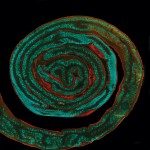Link to Pubmed [PMID] – 26538636
Biol Open 2015 Nov;4(12):1614-24
Skeletal myogenesis in vertebrates is initiated at different sites of skeletal muscle formation during development, by activation of specific control elements of the myogenic regulatory genes. In the mouse embryo, Myf5 is the first myogenic determination gene to be expressed and its spatiotemporal regulation requires multiple enhancer sequences, extending over 120 kb upstream of the Mrf4-Myf5 locus. An enhancer, located at -57/-58 kb from Myf5, is responsible for its activation in myogenic cells derived from the hypaxial domain of the somite, that will form limb muscles. Pax3 and Six1/4 transcription factors are essential activators of this enhancer, acting on a 145-bp core element. Myogenic progenitor cells that will form the future muscle masses of the limbs express the factors necessary for Myf5 activation when they delaminate from the hypaxial dermomyotome and migrate into the forelimb bud, however they do not activate Myf5 and the myogenic programme until they have populated the prospective muscle masses. We show that Msx1 and Meox2 homeodomain-containing transcription factors bind in vitro and in vivo to specific sites in the 145-bp element, and are implicated in fine-tuning activation of Myf5 in the forelimb. Msx1, when bound between Pax and Six sites, prevents the binding of these key activators, thus inhibiting transcription of Myf5 and consequent premature myogenic differentiation. Meox2 is required for Myf5 activation at the onset of myogenesis via direct binding to other homeodomain sites in this sequence. Thus, these homeodomain factors, acting in addition to Pax3 and Six1/4, fine-tune the entry of progenitor cells into myogenesis at early stages of forelimb development.


